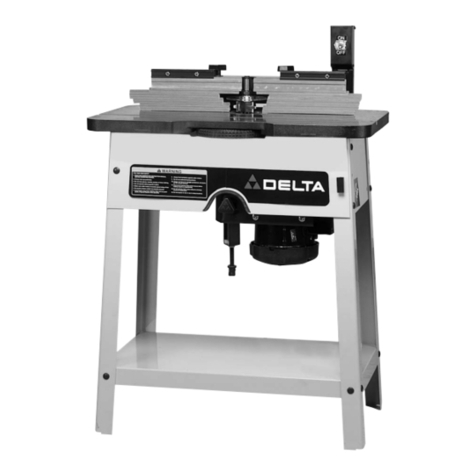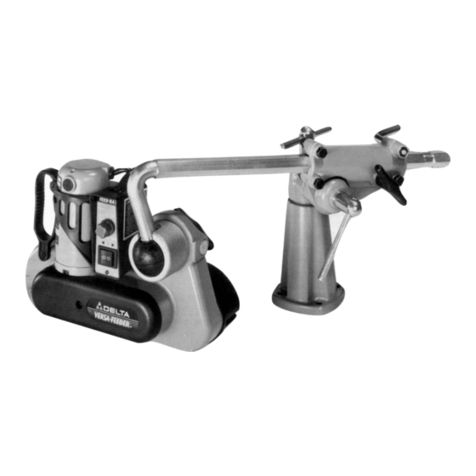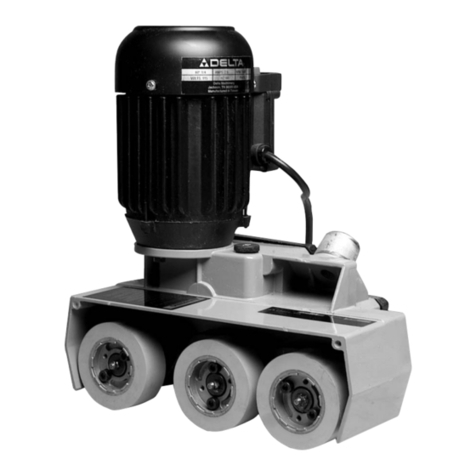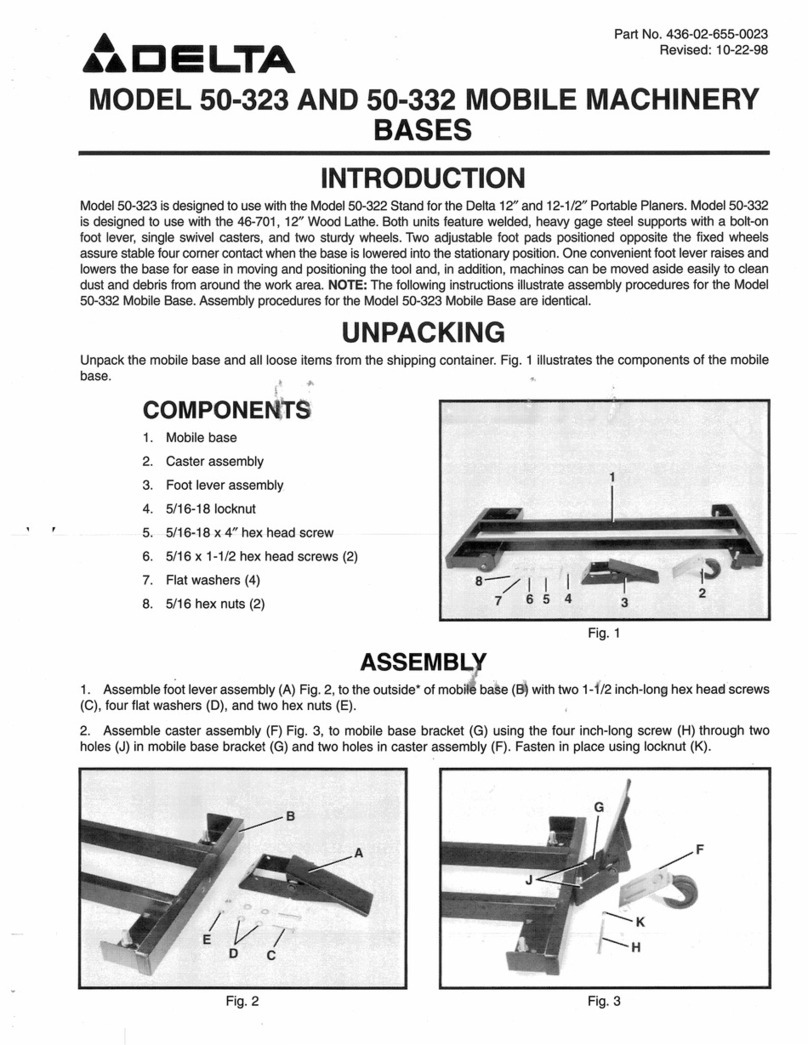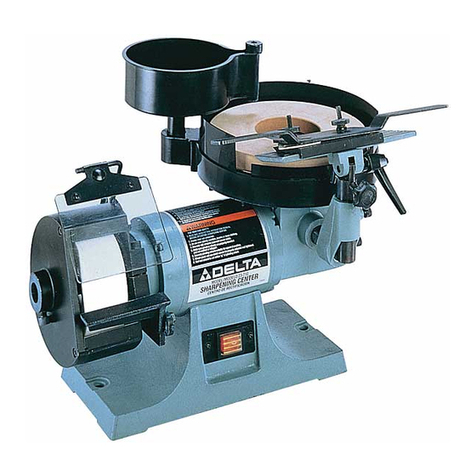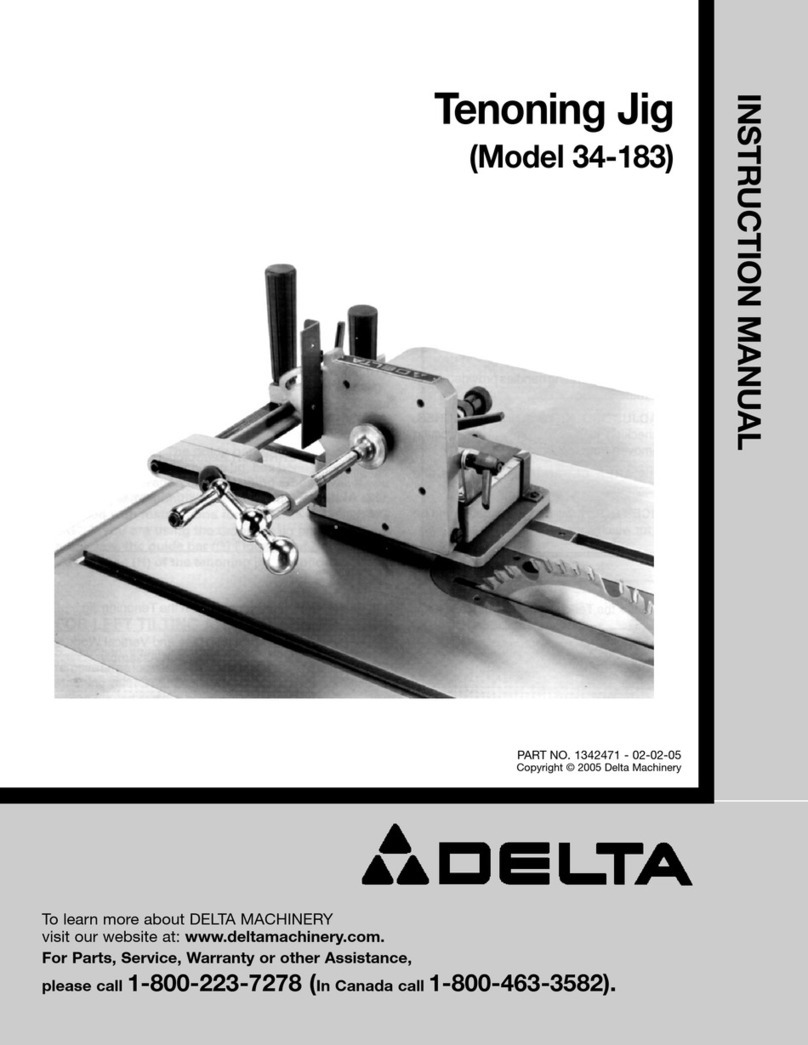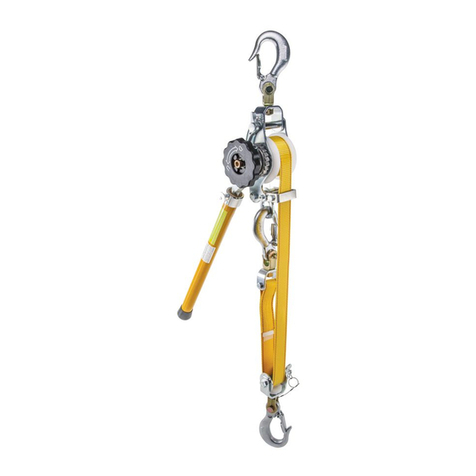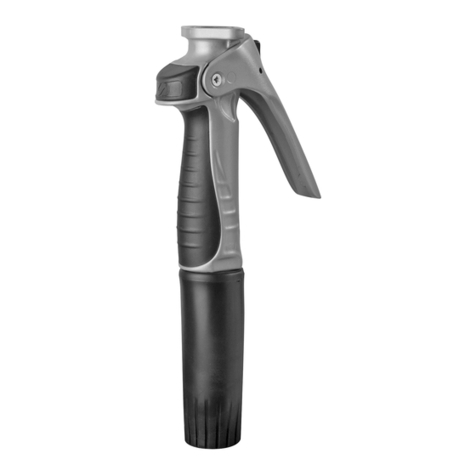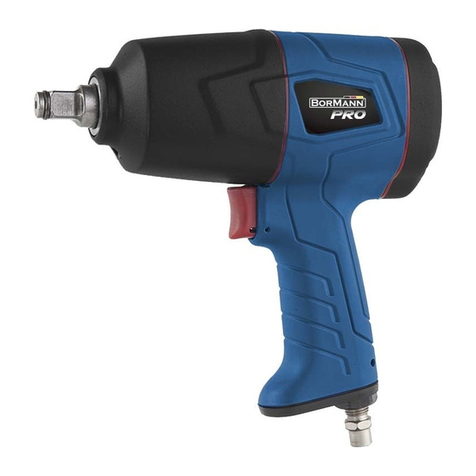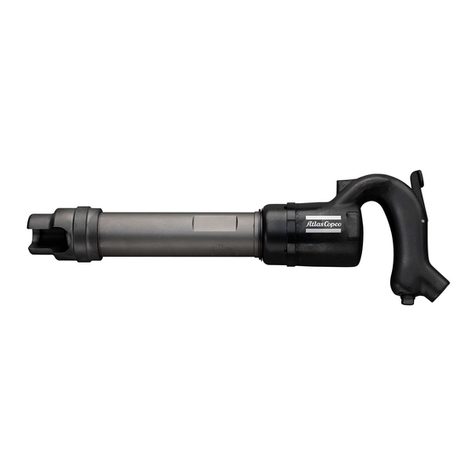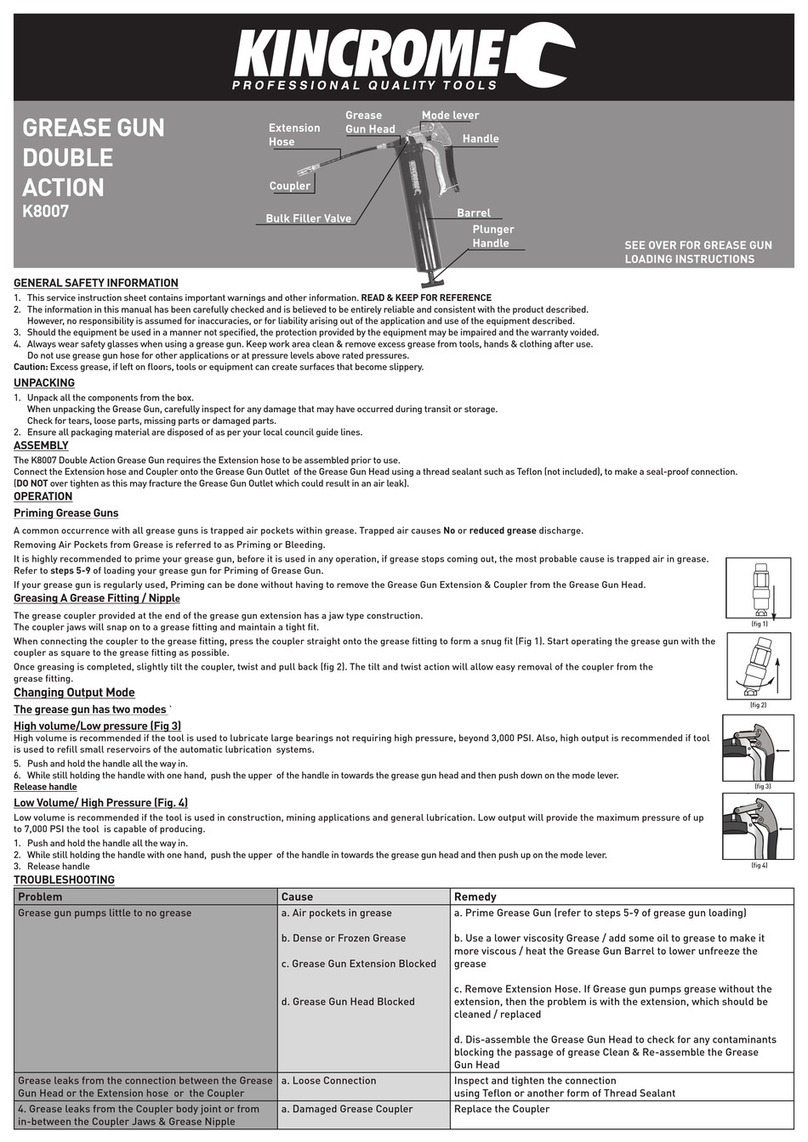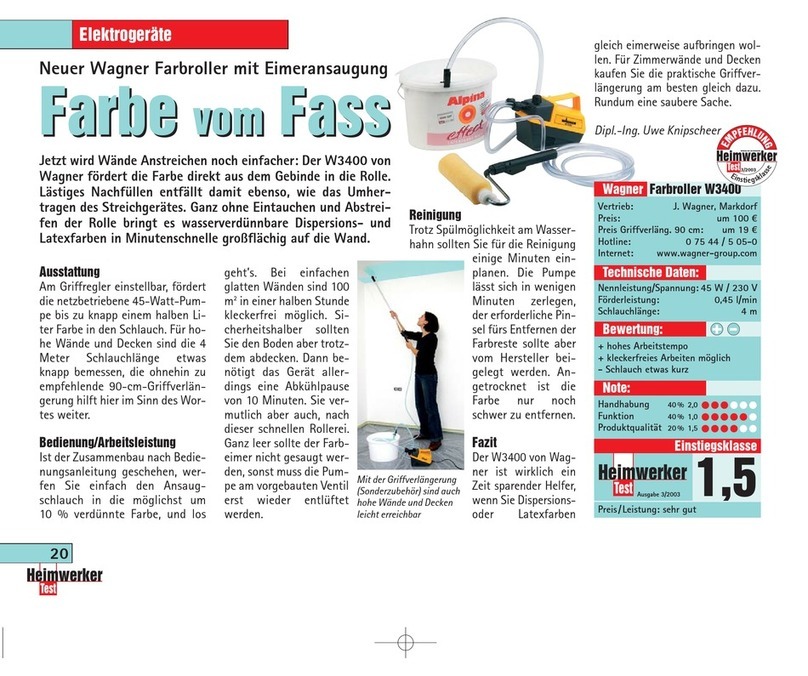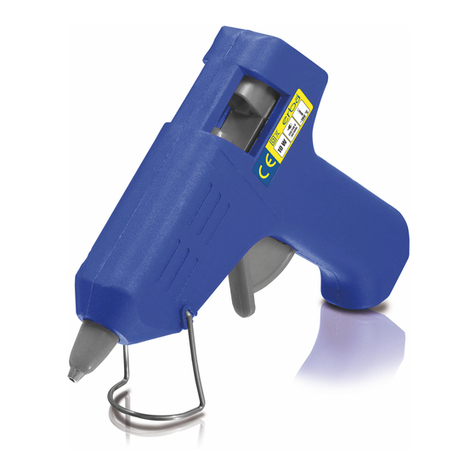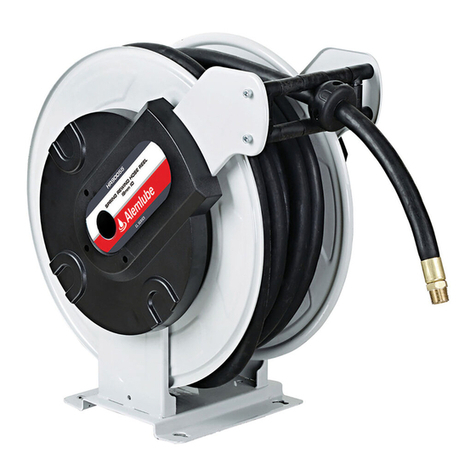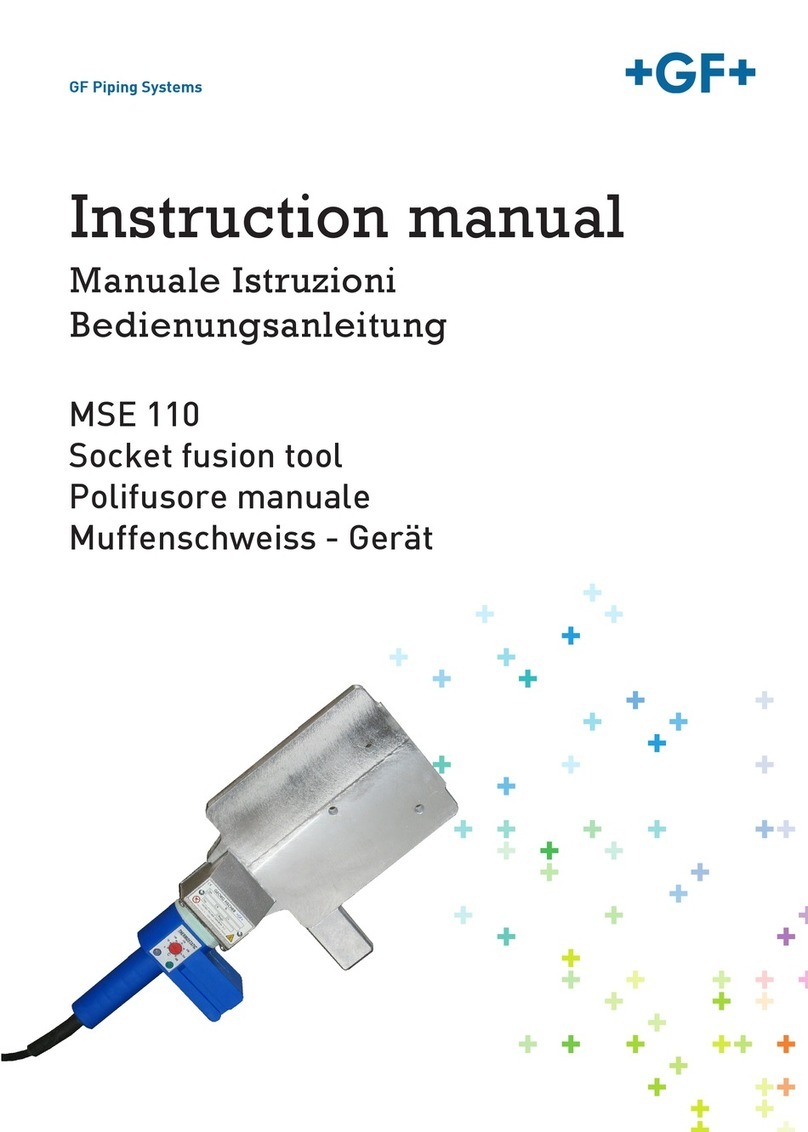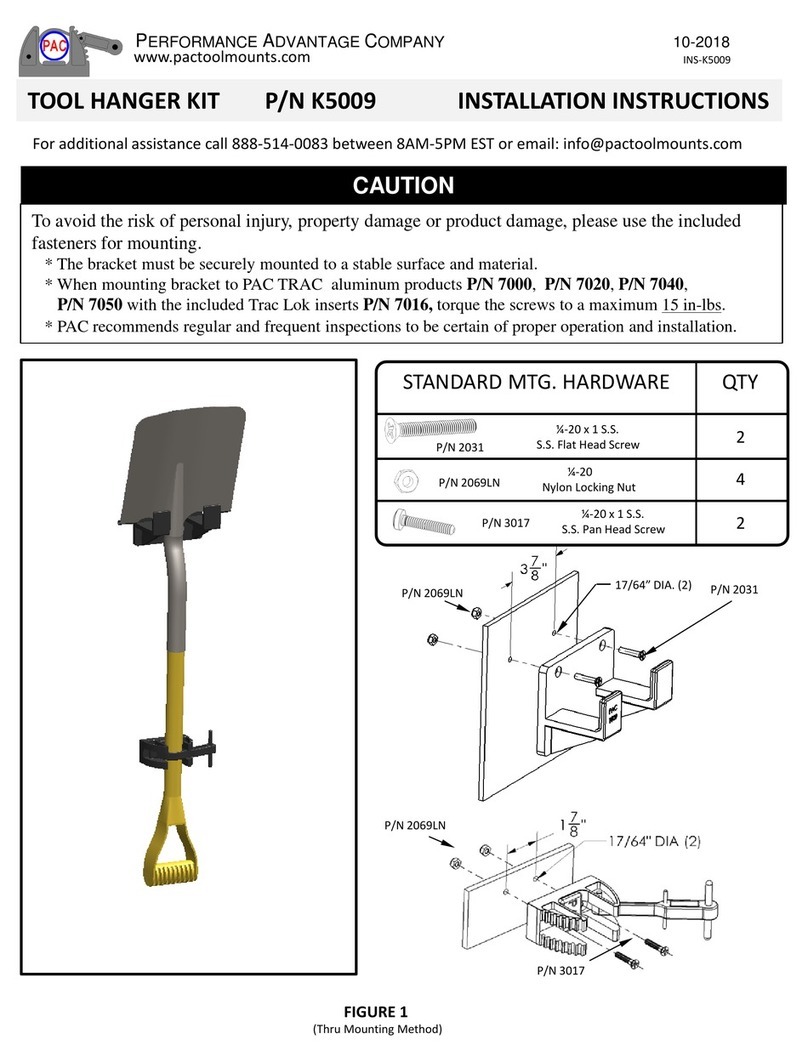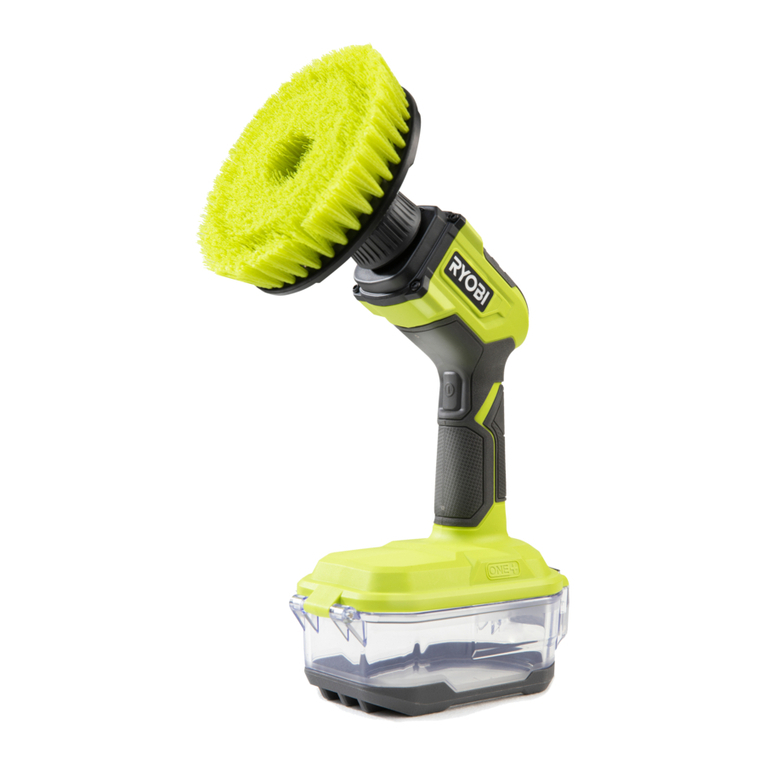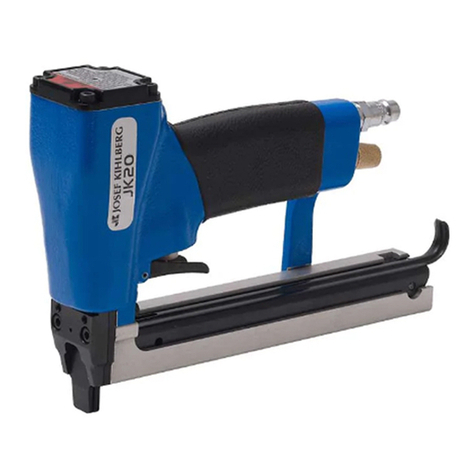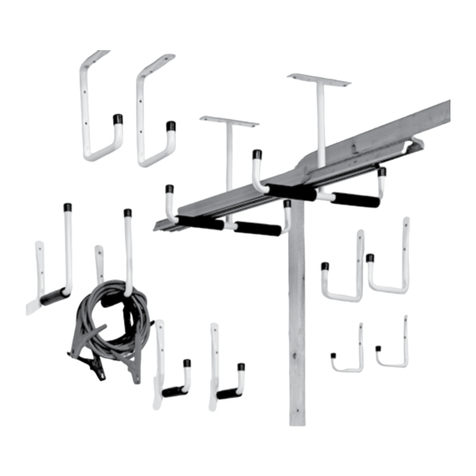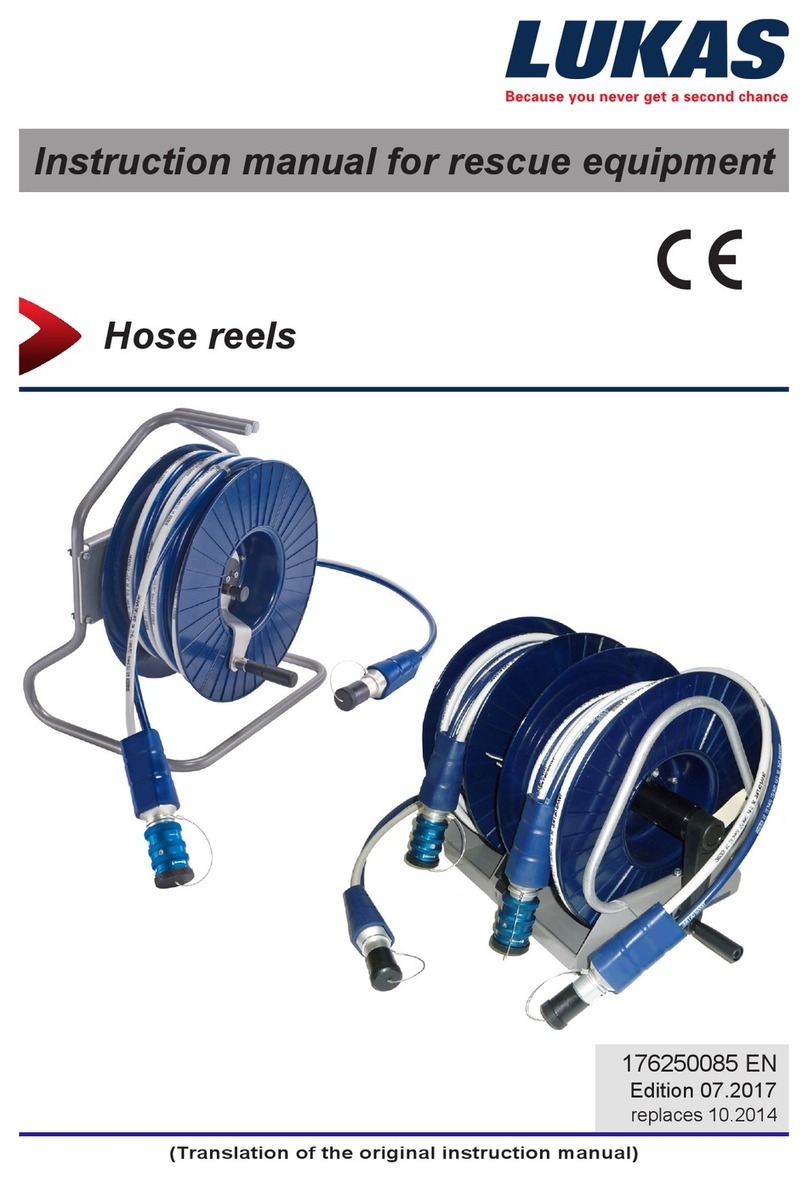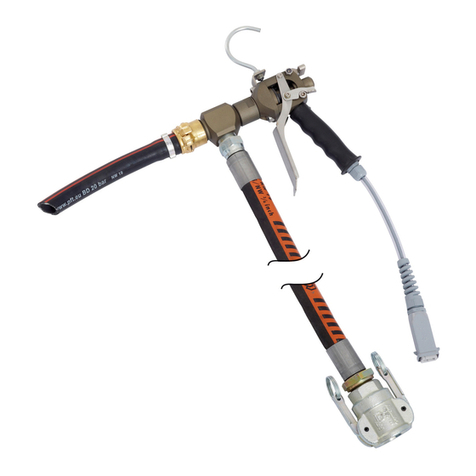Delta 34-184 User manual

INSTRUCTION MANUAL
Tenoning Jig
(Model 34-184)
WRITERS NOTE: FOR TUPELO PRODUCT REMOVE WORD MODEL.
PART NO. 901660 - 02-21-02
Copyright © 2002 Delta Machinery
To learn more about DELTA MACHINERY
visit our website at: www.deltamachinery.com.
For Parts, Service, Warranty or other Assistance,
please call 1-800-223-7278 (In Canada call 1-800-463-3582).

2
GENERAL SAFETY RULES
Woodworking can be dangerous if safe and proper operating procedures are not followed. As with all machinery, there
are certain hazards involved with the operation of the product. Using the machine with respect and caution will
considerably lessen the possibility of personal injury. However, if normal safety precautions are overlooked or ignored,
personal injury to the operator may result. Safety equipment such as guards, push sticks, hold-downs, featherboards,
goggles, dust masks and hearing protection can reduce your potential for injury. But even the best guard won’t make
up for poor judgment, carelessness or inattention. Always use common sense and exercise caution in the workshop.
If a procedure feels dangerous, don’t try it. Figure out an alternative procedure that feels safer. REMEMBER: Your
personal safety is your responsibility.
This machine was designed for certain applications only. Delta Machinery strongly recommends that this machine not
be modified and/or used for any application other than that for which it was designed. If you have any questions relative
to a particular application, DO NOT use the machine until you have first contacted Delta to determine if it can or should
be performed on the product.
Technical Service Manager
Delta Machinery
4825 Highway 45 North
Jackson, TN 38305
(IN CANADA: 505 SOUTHGATE DRIVE, GUELPH, ONTARIO N1H 6M7)
WARNING: FAILURE TO FOLLOW THESE RULES MAY RESULT IN SERIOUS PERSONAL INJURY
1. FOR YOUR OWN SAFETY, READ INSTRUCTION
MANUAL BEFORE OPERATING THE TOOL. Learn the
tool’s application and limitations as well as the specific
hazards peculiar to it.
2. ALWAYS WEAR EYE PROTECTION.
Wear safety
glasses. Everyday eyeglasses only have impact resistant
lenses; they are not safety glasses. Also use face or dust
mask if cutting operation is dusty. These safety glasses
must conform to ANSI Z87.1 requirements. Note:
Approved glasses have Z87 printed or stamped on them.
3. REMOVE ADJUSTING KEYS AND WRENCHES. Form
habit of checking to see that keys and adjusting wrenches
are removed from tool before turning it “on”.
4. KEEP WORK AREA CLEAN. Cluttered areas and
benches invite accidents.
5. DON’T USE IN DANGEROUS ENVIRONMENT. Don’t
use power tools in damp or wet locations, or expose them
to rain. Keep work area well-lighted.
6. KEEP CHILDREN AND VISITORS AWAY. All children
and visitors should be kept a safe distance from work area.
7. MAKE WORKSHOP CHILDPROOF – with padlocks,
master switches, or by removing starter keys.
8. DON’T FORCE TOOL. It will do the job better and be
safer at the rate for which it was designed.
9. USE RIGHT TOOL. Don’t force tool or attachment to
do a job for which it was not designed.
10. WEAR PROPER APPAREL. No loose clothing, gloves,
neckties, rings, bracelets, or other jewelry to get caught in
moving parts. Nonslip footwear is recommended. Wear
protective hair covering to contain long hair.
11. SECURE WORK. Use clamps or a vise to hold work
when practical. It’s safer than using your hand and frees
both hands to operate tool.
12. DON’T OVERREACH. Keep proper footing and
balance at all times.
13. MAINTAIN TOOLS IN TOP CONDITION. Keep tools
sharp and clean for best and safest performance. Follow
instructions for lubricating and changing accessories.
14. DISCONNECT TOOLS before servicing and when
changing accessories such as blades, bits, cutters, etc.
15. USE RECOMMENDED ACCESSORIES. The use of
accessories and attachments not recommended by Delta
may cause hazards or risk of injury to persons.
16. REDUCE THE RISK OF UNINTENTIONAL STARTING.
Make sure switch is in “OFF” position before plugging in
power cord.
In the event of a power failure, move switch
to the “OFF” position.
17. NEVER STAND ON TOOL. Serious injury could occur if
the tool is tipped or if the cutting tool is accidentally
contacted.
18. CHECK DAMAGED PARTS. Before further use of the
tool, a guard or other part that is damaged should be
carefully checked to ensure that it will operate properly and
perform its intended function – check for alignment of
moving parts, binding of moving parts, breakage of parts,
mounting, and any other conditions that may affect its
operation. A guard or other part that is damaged should be
properly repaired or replaced.
19. DIRECTION OF FEED. Feed work into a blade or
cutter against the direction of rotation of the blade or cutter
only.
20. NEVER LEAVE TOOL RUNNING UNATTENDED.
TURN POWER OFF. Don’t leave tool until it comes to a
complete stop.
21.
STAY ALERT, WATCH WHAT YOU ARE DOING, AND
USE COMMON SENSE WHEN OPERATING A POWER
TOOL. DO NOT USE TOOL WHILE TIRED OR UNDER
THE INFLUENCE OF DRUGS, ALCOHOL, OR
MEDICATION. A moment of inattention while operating
power tools may result in serious personal injury.
22. THE DUST GENERATED by certain woods and wood
products can be injurious to your health. Always operate
machinery in well ventilated areas and provide for proper
dust removal. Use wood dust collection systems whenever
possible.
SAVE THESE INSTRUCTIONS.
Refer to them often and use them to instruct others.

3
INTRODUCTION
Your new 34-184 Tenoning Jig will help you produce good, strong joints. There are many methods to join pieces of
wood together but the classic mortise-and-tenon joint is one of the strongest and most widely used joints in
woodworking. The strength of this joint comes from the proportions of the mating parts and from their close mechanical
fit, which all form a good glue bond.
UNPACKING AND CLEANING
Carefully unpack the tool and all loose items from the shipping container(s). Remove the protective coating from all
unpainted surfaces. This coating may be removed with a soft cloth moistened with kerosene (do not use acetone, gasoline
or lacquer thinner for this purpose). After cleaning, cover the unpainted surfaces with a good quality household floor paste
wax.
1 - Base
2 Vertical Work Support Assembly
3 - Clamp Assembly
4 - Handle w/Stud
5 - Special Shoulder Bolt (2)
6 - Clamp Arm
7 - M10 Lockwasher (2)
8 - M10 x 1.5 x 20mm Socket Head Screw (2)
9 - Handle (2)
10 Knob
11 M6.4 Flat Washer
12 - 2.5mm Allen Wrench
13 - 3mm Allen Wrench
14 - 4mm Allen Wrench
15 - 8mm Allen Wrench
Fig. 1
ADDITIONAL SAFETY RULES FOR TENONING JIG
1. MAKE SURE machine power is off and blade is stopped before attempting adjustments to jig or workpiece.
2. KEEP both hands on operating handles provided when processing work material.
3. ALWAYS replace blade guard of saw when finished using the tenoning jig.
4. REFER TO THE OWNERS MANUAL of the tool that the 34-184 Tenoning Jig will be used on for safety rules and
other instructions in regards to tenoning.
1
2
3
4
5
6
7
8
9
10
11
12
13
14
15

4
ASSEMBLY
WARNING: DISCONNECT MACHINE FROM THE
POWER SOURCE AND REMOVE BLADE GUARD
BEFORE USING THE TENONING JIG. REINSTALL
THE BLADE GUARD IMMEDIATELY AFTER
TENONING JIG USE IS COMPLETE. ALWAYS
UNPLUG THE TABLESAW BEFORE REMOVING OR
INSTALLING THE BLADE GUARD. FAILURE TO
COMPLY MAY CAUSE SERIOUS INJURY.
1. Fasten vertical work support assembly (A) Fig 2, to
tenoning jig base (B) with two special shoulder bolts (C),
and place the M6.4 Flat washer onto knob (D) and fasten
to jig base (B).
2. Fasten clamp arm (A) Fig. 3, to the back of the work
support plate using two M10x1.5x20mm socket head
screws (B), and two M10 lockwashers as shown.
3. Fasten clamp assembly (C) Fig. 4, to clamp arm (A)
using the clamp handle with stud (D) as shown.
4. Fasten handles (F) Fig. 4, to the base (H) as shown.
5. IMPORTANT: The guide bar (G) Fig. 4, located on
the base (H) of the tenoning jig, has been preset at
the factory for operation on right tilting arbor saws.
If you are using the tenoning jig on a right tilting
arbor saw, proceed with instructions for “ALIGNING
TENONING JIG”. If you are using the tenoning jig on
a left tilting arbor saw, the guide bar (G) Fig. 4, must
be relocated on the base (H) of the tenoning jig, as
follows:
FOR LEFT TILTING ARBOR SAWS ONLY
NOTE: PLACE THE TENONING JIG IN THE MITER
GAUGE SLOT TO THE LEFT OF THE BLADE.
6. Using a 3mm allen wrench, loosen set screw (M)
Fig. 6, while pushing in on thread release button (P),
remove micro-adjustment assembly (N) from tenoning
jig as shown in Fig. 7.
7. Loosen and remove lock handle (K) and flat washer
Fig. 5, from tenoning jig.
Fig. 2
Fig. 3
Fig. 4
Fig. 6Fig. 5
B
A
C
C
D
BA
K
P
N
M
C
A
D
F
H
G

5
8. Lift jig assembly (P) Fig. 8, from base (H). Loosen
and remove two button head screws, and lockwashers
(R) from base.
9. Slide base (H) Fig. 9, to the left, until two holes (S)
are aligned with holes in guide bar (G). Fasten base to
guide bar with two button head screws and flat washers
(R) as shown in Fig. 10.
10. Reassemble items that were removed in STEPS 6,
7, and 8in reverse order. Fig. 11, illustrates the tenoning
jig reassembled for operation on a left tilting arbor saw.
Fig. 8
Fig. 9
Fig. 10 Fig. 11
Fig. 7
N
H
G
R
PR
H
S
R
G
H

6
ADJUSTING GUIDE BAR
TO TABLE SLOT
CAUTION: DISCONNECT MACHINE FROM POWER
SOURCE.
1. The tenoning jig is furnished with an adjustable guide
bar (A) Fig. 12, which allows the jig to be custom-fit to
your saw, eliminating any side-to-side play. Also, there is
a T-slot washer (B) on each end of the guide bar (A) to
keep the tenoning jig from lifting during operation.
NOTE: T-slot washers (B) need to be removed if your
table saw is not equipped with T-slotted miter gage slots.
2. Place tenoning jig guide bar (A) Fig. 13, into left miter
slot (D) of machine as shown and slide miter gage back
and forth to determine if there is any side-to-side play. If
there is no side-to-side play and the tenoning jig slides
easily through the miter slot of the machine, no
adjustment is necessary; however, if the tenoning jig fits
too snugly, or if there is excessive play between the
guide bar (A), and miter slot (D) of the machine, proceed
as follows:
3. Remove tenoning jig from machine and place it
upside down as shown in Fig. 12.
4. Using the 2.5mm allen wrench (not shown) adjust
screws (C) Fig. 12, clockwise to eliminate play, or
counter-clockwise to provide a looser fit between the
guide bar (A) Fig. 13, and miter slot (D). Then insert the
tenoning jig back into the miter slot of the machine and
determine that fit is suitable, or if further adjustments are
required.
Fig. 12
Fig. 13
ALIGNING TENONING JIG
CAUTION: DISCONNECT MACHINE FROM POWER
SOURCE.
1. Place the tenoning jig guide bar (A) Fig. 13, into the
left miter gage slot.
2. Using a square (E) Fig. 13, check to see if the vertical
work support plate (F) is 90 degrees to the saw table. If
an adjustment is necessary, loosen lock handle (G),
move vertical work support plate (F) until it is 90 degrees
to the table and tighten lock handle (G).
3. With the vertical work support plate (F) Fig. 14,
adjusted at 90 degrees to the table, tighten set screw (H)
until it bottoms. This positive stop set screw (H) enables
you to rapidly position the vertical work support (F) 90
degrees to the table after it has been tilted.
4. The tenoning jig features a positive stop to ensure
fast and accurate positioning of the backstop (G) Fig. 15,
at 90 degrees to the saw table. To check and adjust the
positive stop at 90 degrees, loosen lock knob (H) Fig. 15,
and place one end of a combination square (J) on the
saw table and the other end against backstop (G). Check
to see if the backstop is at 90 degrees to the saw table.
If an adjustment is necessary, loosen locknut (K) Fig. 15,
and adjust screw (L) until head of screw contacts the
casting on vertical plate (M) at 90 degrees. Tighten
locknut (K) and lock knob (H) after adjustment is made.
Fig. 14
Fig. 15
A
B
B
C
D
A
G
E
F
F
H
H
K
L
M
JG

7
5. Loosen nut (L) Fig. 16, and turn set screw (K)
counter-clockwise two or three times.
6. Loosen knob (N) and hold down quick release button
(P) Fig. 17, and move jig (R) until vertical work support
plate (F) is against saw blade and tighten lever (N).
7. Check to see if the vertical work support plate (F)
Fig. 17, is parallel with the saw blade.
8. If an adjustment is necessary, loosen knob (N) Fig.
17, and hold down the quick release button (P) and move
the tenoning jig to align holes (T) with guide bar (X) and
gain access to set screws. Loosen two screws inside
holes (T) and move jig (R) until vertical work support plate
(F) is parallel with the saw blade. Then tighten the two
screws inside holes (T).
9. Move jig (R) Fig. 17, 1/8" away from blade so vertical
work support plate (F) clears saw blade; tighten knob (N).
10. Turn screw (K) Fig. 18, clockwise until it bottoms.
This prevents the vertical work support plate (F) from
accidentally being moved into the blade; tighten nut (L).
11. Loosen screw (Y) Fig. 19, and adjust pointer (Z) to
the 1/8" mark on scale.
Fig. 16
Fig. 17
Fig. 18
Fig. 19
L
K
L
K
FPV
S
N
R
X
T
T
Y
Z

8
ADJUSTMENTS
CAUTION: DISCONNECT TOOL FROM POWER SOURCE.
1. For rapid adjustment of the work support plate (A)
Fig. 20, loosen lock knob (B), hold down quick release
button (C), and move jig (D) as necessary. Tighten lock
knob (B) and let loose of quick release button (C) after
adjustment is made.
2. Fine adjustment of the work support plate (A) Fig. 20,
can be accomplished by loosening lock knob (B) and
rotating knob (E) until plate (A) is at the desired position.
Tighten knob (B) Fig. 20, after fine adjustment is made.
Each index mark on (E) Fig. 20 is approximately to .004",
a full rotation of knob (E) is approximately 1/16".
3. To tilt the vertical work support plate (A) Fig. 20,
loosen lock knob (F), tilt vertical work support plate to
the desired angle and tighten lock knob (F).
4. To adjust backstop (G) Fig. 21, for angled tenons,
loosen lock knob (H), adjust backstop (G) to the desired
angle and tighten knob (H).
5. IMPORTANT: THE TENONING JIG IS NOT EQUIP-
PED WITH A BEVEL SCALE FOR THE POSITIONING
OF BACKSTOP (G) FIG. 21, OR SUPPORT PLATE (A)
FIG. 20. FOR THE DESIRED ANGLE, THE WORK-
PIECE SHOULD BE CUT PRIOR TO THE SET UP OF
THE JIG AND USED AS THE ANGLE REFERENCE.
Fig. 20
Fig. 21
A
C
E
B
F
D
G
G
H

9
6. To eliminate chip-out of the workpiece when
performing cheek cuts, an auxiliary wooden backup
board can be fastened to the backstop (G) Fig. 23, with
two wood screws through the two pre-drilled holes (N).
Fig. 24 illustrates a backup board (P) fastened to the
backstop.
7. A block of wood may also be fastened to the vertical
support plate (R) Fig. 24, through four pre-drilled holes
(S) to prevent the saw blade from contacting the jig in
certain set-ups.
Fig. 23
Fig. 24
OPERATION
This jig is intended to perform the cheek cuts of the
tenon only. The cheek cuts are usually performed before
the shoulder cuts, which are usually cut on a table saw
using the miter gage.
WARNING: KEEP HANDS ON JIG HANDLES
WHEN PERFORMING CUTS (SEE FIGS. 30 & 31).
CAUTION: DISCONNECT MACHINE FROM POWER
SOURCE.
STRUCTURE OF A MORTISE
AND TENON JOINT
Fig. 25, illustrates the parts of a simple or “blind” mortise
and tenon joint.
A. Structural Shoulder
B. Cheek
C. Cosmetic Shoulder
D. Mortise
E. Mortise Walls
Start by laying out the mortise and tenon onto the
workpieces a shown in Fig. 26, but keep the following
items in consideration when laying out the joints:
• To avoid premature joint failure, avoid locating a tenon
in a disfigured part of the grain such as a knot, for
unpredictable movement of the joint may occur.
Always use straight, flat, common-grained stock as
shown in Fig. 25.
• The tenon will shrink in width, away from the mortise
walls, possibly revealing the mortised hole; therefore,
when possible, tenons should have shoulders on all
four sides, two structural and two cosmetic, to
conceal the mortised hole when wood movement
occurs.
Fig.25
Fig.26
G
N
P
S
R
A
C
B
D
E

10
• The objective when making a mortise-and-tenon joint
is to make the parts fit closely together, and maximize
the gluing surface by making the tenon as long as
possible, approximately 1/2 the width of the stile, or
longer if using narrow stock. Balance the joint by
making sure there is the same amount of wood in the
tenon as there is in the combined thickness of the
mortise walls; example shown in Fig. 27. If one piece
of wood is larger than the other, make the tenon as
thick as possible. See Fig. 28.
• Remember to figure in the width of the saw blade
when setting up for the cut.
• Cut all mortises first, making the mortise 1/16" deeper
than the length of the tenon to allow for squeezed
glue.
There are several methods in which a mortise-and-tenon
can be cut. The following information illustrates one of
the easiest and safest methods. This method requires
the cheek cuts to be made first, then the shoulder cuts
are performed. A base stop (F) Fig. 29, which is the same
thickness as the base plate (G) of the tenon jig (H), and
spacer block (K), which is equal to the combined
thickness of the tenon and the saw blade, will be used to
make cutting more efficient. This method of cutting
eliminates any possible errors which may occur due to
thickness variations in the material, and avoids trapping
the cut-off pieces between the saw blade and vertical
support plate (N).
NOTE: IT IS ADVISABLE TO PERFORM CUTS ON
PRACTICE MATERIAL FIRST BEFORE CUTTING THE
GOOD WORK PIECES.
WARNING: When performing cuts with this tenon
jig, a slow feed rate is suggested to help prevent the
tenon jig from lifting during a cut.
1. Clamp a base stop (F) Fig. 29, which is the same
thickness as the base plate (G) of the tenon jig (H), onto
the front of the saw table as shown, so the tenon jig can
pass over the base stop (F) without contacting it.
2. Fabricate a spacer block of wood (K) Fig. 29, equal
to the thickness of the tenon plus the thickness of the
saw blade.
3. With the tenon jig (H) Fig. 29, located at the front of
saw table and over base stop (F), load the spacer block
(K) and workpiece (L) and securely clamp in place by
turning clamp handle (M), making certain both pieces of
wood are against vertical support plate (N) and backup
board (P) as shown.
4. Gently push tenon jig (H) Fig. 29, toward saw blade
until work piece is near the saw blade. Adjust tenon jig
(H) and saw blade so the first cheek cut can be made.
Then return the tenon jig (H) to the front of saw table.
Fig. 27
Fig. 28
Fig. 29
L
P
K
N
H
G
F
M

11
5. Connect saw to power source.
WARNING: KEEP HANDS ON JIG HANDLES
WHEN PERFORMING CUTS (SEE FIGS. 30 & 31).
6. Turn saw on and perform the first structural cheek
cut as shown in Fig. 30, by feeding the tenon jig toward
the saw blade at a slow feed rate until the saw blade has
exited out of the back of the work piece. Turn tool off and
allow blade to come to a complete stop, then slowly pull
tenon jig back to the position shown in Fig. 29.
7. Loosen clamp (M) Fig. 29, remove spacer block (K),
and secure workpiece (L) Fig. 31, in place as shown,
keeping the same face of workpiece (L) against vertical
support plate (N) and backup board (P), and the
workpiece is properly spaced up from the saw table as
shown. Then turn tool on, perform the second structural
cheek cut as shown, then turn tool off and allow blade to
come to a complete stop, then slowly pull tenon jig back
to the position shown in Fig. 29.
CAUTION: DISCONNECT MACHINE FROM POWER
SOURCE.
8. Load and secure the workpiece (L) Fig. 32, onto the
tenon jig as shown and adjust the tenon jig to perform
the third and fourth cosmetic cheek cuts. Connect saw
to power source, turn saw on, and perform the cosmetic
cheek cuts in the same manner the structural cheek cuts
were made. NOTE: When cutting the cosmetic cheek
cuts, the spacer block (K) Fig. 29, does not need to be
used. The workpiece can be turned 180 degrees, for the
discrepancies in the material are not as critical when
cutting the cosmetic cheeks compared to the structural
cheeks.
CUTTING THE SHOULDERS
OF THE TENON
CAUTION: DISCONNECT MACHINE FROM POWER
SOURCE.
WARNING: TO AVOID PERSONAL INJURY OR
DAMAGE TO THE MACHINE, ALWAYS USE A
CROSS-CUT BLADE TO PERFORM THE SHOULDER
CUTS OF THE TENON.
CAUTION: WHEN PERFORMING THE SHOULDER
CUTS OF THE TENON, DO NOT CUT INTO THE
CHEEKS OF THE TENON, FOR IT WILL GREATLY
REDUCE THE STRENGTH OF THE JOINT.
NOTE: IT IS ADVISABLE TO PERFORM CUTS ON
PRACTICE MATERIAL FIRST BEFORE CUTTING THE
GOOD WORKPIECES.
9. Remove tenon jig from tool.
10. Lay the workpiece (L) Fig. 33, onto the saw table as
shown and adjust saw blade (R) to cut the structural
shoulders of the tenon, as shown.
Fig. 30
Fig. 31
Fig.32
Fig.33
L
N
P
L
N
R
L

12
11. Clamp a wooden stop block (S) Fig. 34, to the front
of the saw fence (T) as shown, and adjust the saw fence
to cut the structural shoulders of the tenon. NOTE:
Remember to figure in the width of the saw blade.
WARNING: Always position wooden stop block (S)
Fig. 34, in front of the saw blade so the workpiece
cannot be trapped between the saw fence and saw
blade to avoid kickback. The piece of material being
cut must be clear of the wooden stop block (S) before
contacting the saw blade.
12. Using a miter gage (W) Fig. 34, equipped with a
backup board (X), position the workpiece (L) so the
structural shoulders can be cut as shown. Make certain
the workpiece (L) is against wooden stop block (S) and
backup board (X) as shown.
13. Connect saw to the power source.
14. Turn the tool on and perform the structural shoulder
cut by slowly pushing the miter gage (W) Fig. 34, toward
the saw blade as shown until the saw blade has exited
out the rear of the work piece as shown in Fig. 35. Then
turn tool off, and remove cut-off piece after the blade
has come to a complete stop.
15. Return miter gage (W) Fig. 34, to the position shown,
and perform the other structural shoulder cuts in the
same manner.
16. Fig. 36, illustrates workpiece (L) with the two
structural shoulders cut.
CAUTION: DISCONNECT TOOL FROM POWER
SOURCE.
17. Readjust the blade height to perform the cosmetic
shoulder cuts, connect saw to power source, and
perform the cosmetic shoulder cuts in the same manner
in which the structural shoulder cuts were made. NOTE:
WHEN PERFORMING THE SHOULDER CUTS OF THE
TENON, DO NOT CUT INTO THE CHEEKS OF THE
TENON, FOR IT WILL GREATLY REDUCE THE
STRENGTH OF THE JOINT.
18. Fig. 37, illustrates a simple, or “blind” mortise-and-
tenon joint.
Fig. 34
Fig. 35
Fig.36
Fig.37
X
W
L
T
S
S
X
L
T
L

13
HAUNCHED
TENON CONCEALED
HAUNCHED
TENON
MITERED
TENON
TENON
ENDS
MITERED
SAW
CUTS
THROUGH-WEDGED
TENON
BARE FACED
TENON
SIMPLE MORTISE
AND TENON
MORTISE CHEEK OF
TENON
SHOULDER OF
TENON
BLIND-WEDGED
TENON
WEDGE
TENON WITH LONG AND
SHORT SHOULDERS
RABBET
STUB
TENON
MORTISE AND TENON
WITH SPLINES
SPLINE GROOVE
(SINGLE SAW CUT)
SPLINE
OPEN MORTISE
TENON
EXAMPLES OF MORTISE-AND-TENON JOINTS

14

15
Two Year Limited Warranty
Delta will repair or replace, at its expense and at its option, any Delta machine, machine part, or machine accessory which
in normal use has proven to be defective in workmanship or material, provided that the customer returns the product
prepaid to a Delta factory service center or authorized service station with proof of purchase of the product within two
years and provides Delta with reasonable opportunity to verify the alleged defect by inspection. Delta may require that
electric motors be returned prepaid to a motor manufacturer’s authorized station for inspection and repair or replacement.
Delta will not be responsible for any asserted defect which has resulted from normal wear, misuse, abuse or repair or
alteration made or specifically authorized by anyone other than an authorized Delta service facility or representative. Under
no circumstances will Delta be liable for incidental or consequential damages resulting from defective products. This
warranty is Delta’s sole warranty and sets forth the customer’s exclusive remedy, with respect to defective products; all
other warranties, express or implied, whether of merchantability, fitness for purpose, or otherwise, are expressly
disclaimed by Delta.
Printed in U.S.A.
PARTS, SERVICE OR WARRANTY ASSISTANCE
All Delta Machines and accessories are manufactured to high quality standards and are serviced by a network
of Porter-Cable • Delta Factory Service Centers and Delta Authorized Service Stations. To obtain additional
information regarding your Delta quality product or to obtain parts, service, warranty assistance, or the location
of the nearest service outlet, please call 1-800-223-7278 (In Canada call 1-800-463-3582).
ACCESSORIES
A complete line of accessories is available from your Delta Supplier, Porter-Cable • Delta Factory Service Centers,
and Delta Authorized Service Stations. Please visit our Web Site www.deltamachinery.com for a catalog or
for the name of your nearest supplier.
WARNING: Since accessories other than those offered by Delta have not been tested
with this product, use of such accessories could be hazardous. For safest operation, only
Delta recommended accessories should be used with this product.

The following are trademarks of PORTER-CABLE
·
DELTA (Las siguientes son marcas registradas de PORTER-CABLE S.A.): BAMMER®,
INNOVATION THAT WORKS®, JETSTREAM®, LASERLOC®, OMNIJIG®, POCKET CUTTER®, PORTA-BAND®, PORTA-PLANE®, PORTER-
CABLE®, QUICKSAND®, SANDTRAP®, SAW BOSS®, SPEED-BLOC®, SPEEDMATIC®, SPEEDTRONIC®, STAIR-EASE®, THE PROFESSIONAL
EDGE®, THE PROFESSIONAL SELECT®, TIGER CUB®, TIGER SAW®, TORQBUSTER®, WHISPER SERIES®, DURATRONIC™, FLEX™,
FRAME SAW™, MICRO-SET™, MORTEN™, NETWORK™, RIPTIDE™, TRU-MATCH™, WOODWORKER’S CHOICE™, THE AMERICAN
WOOD SHOP™ (design) , AUTO-SET™, B.O.S.S.™, BUILDER’S SAW™, CONTRACTOR’S SAW™, DELTA™, DELTACRAFT™,
HOMECRAFT™, JET-LOCK™, KICKSTAND™, THE LUMBER COMPANY™ (design). MICRO-SET™, Q3™, QUICKSET II™, QUICKSET
PLUS™, SAFEGUARD II™, SANDING CENTER™, SIDEKICK™, UNIFENCE™, UNIGUARD™, UNIRIP™, UNISAW™, VERSA-FEEDER™ ,
TPS™, Emc²™.
Trademarks noted with ™ and ® are registered in the United States Patent and Trademark Office and may also be registered in other
countries. Las Marcas Registradas con el signo de ™ y ® son registradas por la Oficina de Registros y Patentes de los Estados Unidos y
también pueden estar registradas en otros países.
PORTER-CABLE • DELTA SERVICE CENTERS
(CENTROS DE SERVICIO DE PORTER-CABLE • DELTA)
Parts and Repair Service for Porter-Cable
•
Delta Machinery are Available at These Locations
(Obtenga Refaccion de Partes o Servicio para su Herramienta en los Siguientes Centros de Porter-Cable
•
Delta)
Authorized Service Stations are located in many large cities. Telephone 800-438-2486 or 731-541-6042 for assistance locating one.
Parts and accessories for Porter-Cable
·
Delta products should be obtained by contacting any Porter-Cable
·
Delta Distributor, Authorized
Service Center, or Porter-Cable
·
Delta Factory Service Center. If you do not have access to any of these, call 800-223-7278 and you will
be directed to the nearest Porter-Cable
·
Delta Factory Service Center. Las Estaciones de Servicio Autorizadas están ubicadas en muchas
grandes ciudades. Llame al 800-438-2486 ó al 731-541-6042 para obtener asistencia a fin de localizar una. Las piezas y los accesorios
para los productos Porter-Cable
·
Delta deben obtenerse poniéndose en contacto con cualquier distribuidor Porter-Cable
·
Delta, Centro
de Servicio Autorizado o Centro de Servicio de Fábrica Porter-Cable
·
Delta. Si no tiene acceso a ninguna de estas opciones, llame al
800-223-7278 y le dirigirán al Centro de Servicio de Fábrica Porter-Cable
·
Delta más cercano.
ARIZONA
Tempe 85282 (Phoenix)
2400 West Southern Avenue
Suite 105
Phone: (602) 437-1200
Fax: (602) 437-2200
CALIFORNIA
Ontario 91761 (Los Angeles)
3949A East Guasti Road
Phone: (909) 390-5555
Fax: (909) 390-5554
San Leandro 94577 (Oakland)
3039 Teagarden Street
Phone: (510) 357-9762
Fax: (510) 357-7939
FLORIDA
Davie 33314 (Miami)
4343 South State Rd. 7 (441)
Unit #107
Phone: (954) 321-6635
Fax: (954) 321-6638
Tampa 33609
4538 W. Kennedy Boulevard
Phone: (813) 877-9585
Fax: (813) 289-7948
GEORGIA
Forest Park 30297 (Atlanta)
5442 Frontage Road,
Suite 112
Phone: (404) 608-0006
Fax: (404) 608-1123
ILLINOIS
Addison 60101 (Chicago)
311 Laura Drive
Phone: (630) 628-6100
Fax: (630) 628-0023
Woodridge 60517 (Chicago)
2033 West 75th Street
Phone: (630) 910-9200
Fax: (630) 910-0360
MARYLAND
Elkridge 21075 (Baltimore)
7397-102 Washington Blvd.
Phone: (410) 799-9394
Fax: (410) 799-9398
MASSACHUSETTS
Braintree 02185 (Boston)
719 Granite Street
Phone: (781) 848-9810
Fax: (781) 848-6759
Franklin 02038 (Boston)
Franklin Industrial Park
101E Constitution Blvd.
Phone: (508) 520-8802
Fax: (508) 528-8089
MICHIGAN
Madison Heights 48071 (Detroit)
30475 Stephenson Highway
Phone: (248) 597-5000
Fax: (248) 597-5004
MINNESOTA
Minneapolis 55429
5522 Lakeland Avenue North
Phone: (763) 561-9080
Fax: (763) 561-0653
MISSOURI
North Kansas City 64116
1141 Swift Avenue
P.O. Box 12393
Phone: (816) 221-2070
Fax: (816) 221-2897
St. Louis 63119
7574 Watson Road
Phone: (314) 968-8950
Fax: (314) 968-2790
NEW YORK
Flushing 11365-1595 (N.Y.C.)
175-25 Horace Harding Expwy.
Phone: (718) 225-2040
Fax: (718) 423-9619
NORTH CAROLINA
Charlotte 28270
9129 Monroe Road, Suite 115
Phone: (704) 841-1176
Fax: (704) 708-4625
OHIO
Columbus 43214
4560 Indianola Avenue
Phone: (614) 263-0929
Fax: (614) 263-1238
Cleveland 44125
8001 Sweet Valley Drive
Unit #19
Phone: (216) 447-9030
Fax: (216) 447-3097
OREGON
Portland 97230
4916 NE 122 nd Ave.
Phone: (503) 252-0107
Fax: (503) 252-2123
PENNSYLVANIA
Willow Grove 19090
520 North York Road
Phone: (215) 658-1430
Fax: (215) 658-1433
TEXAS
Carrollton 75006 (Dallas)
1300 Interstate 35 N, Suite 112
Phone: (972) 446-2996
Fax: (972) 446-8157
Houston 77055
West 10 Business Center
1008 Wirt Road, Suite 120
Phone: (713) 682-0334
Fax: (713) 682-4867
WASHINGTON
Auburn 98001(Seattle)
3320 West Valley HWY, North
Building D, Suite 111
Phone: (253) 333-8353
Fax: (253) 333-9613
Printed in U.S.A.
CANADIAN PORTER-CABLE • DELTA SERVICE CENTERS
ALBERTA
Bay 6, 2520-23rd St. N.E.
Calgary, Alberta
T2E 8L2
Phone: (403) 735-6166
Fax: (403) 735-6144
BRITISH COLUMBIA
8520 Baxter Place
Burnaby, B.C.
V5A 4T8
Phone: (604) 420-0102
Fax: (604) 420-3522
MANITOBA
1699 Dublin Avenue
Winnipeg, Manitoba
R3H 0H2
Phone: (204) 633-9259
Fax: (204) 632-1976
ONTARIO
505 Southgate Drive
Guelph, Ontario
N1H 6M7
Phone: (519) 836-2840
Fax: (519) 767-4131
QUÉBEC
1515 ave.
St-Jean Baptiste,
Québec, Québec
G2E 5E2
Phone: (418) 877-7112
Fax: (418) 877-7123
1447, Begin
St-Laurent, (Montréal),
Québec
H4R 1V8
Phone: (514) 336-8772
Fax: (514) 336-3505
Table of contents
Other Delta Tools manuals

